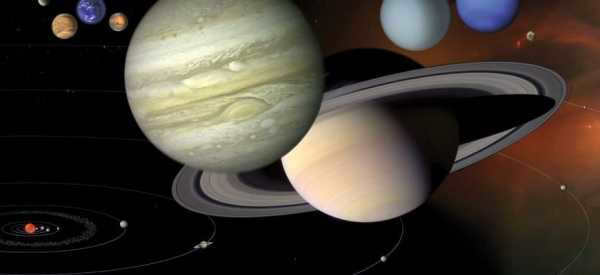
The solar system
As of 2005, according to the official account, the solar system consists of 8 planets. However, Pluto, which is classified as a dwarf planet, was excluded from this list. This decision was made due to its relatively low mass, which prevents it from maintaining sufficient gravity and a spherical shape. In this article, we will explore the mass of each planet in the solar system.
Mercury
Situated in close proximity to the Sun, at a distance of 58 million kilometers. This celestial body possesses the smallest dimensions, with a diameter measuring 4,800 km. The orbital period lasts for 87 days (equivalent to the length of a day on Mercury). Its mass is 0.055 times that of Earth, specifically an exact value of 3.3011 * 10^23 kilograms. Mercury is devoid of any natural satellites. The force of gravity experienced on this planet is half that of our own. The temperature range experienced here spans from -170 to +400 degrees.
Venus
Venus is located at a distance of 108 million kilometers from the Earth. It has a diametral cross-section that is similar to our planet, but slightly smaller. When comparing the mass of planets in the solar system, Venus has a value of 0.81 times that of Earth. This means that its exact mass is 4.886*10^24 kilograms. Venus has an annual period that lasts for 225 days. It also has an atmospheric layer. The brightness of Venus often leads to confusion, as some people mistake it for a UFO.
The distance between us and the celestial body is approximately 150 million kilometers. The precise weight is 5.97*10^24 kg. It is widely known that one year consists of 365 days. The temperature range varies from +60 to -90 degrees. The ratio of water to land on this planet is constantly fluctuating. Researchers assert that this particular planet is the sole location within the group being examined that harbors life.
Mars
Mars is located approximately 300 million kilometers away from the sun. It is often referred to as the “Red Planet” due to its reddish surface. Although Mars has a thin atmosphere, it is not very extensive. In terms of mass, Mars is quite significant compared to other planets in the solar system, with a mass of approximately 6.4171 * 10^24 units. It takes Mars about 687 days to complete a full orbit around the sun.
Jupiter
Jupiter is an enormous celestial object situated approximately 800 million km away from the Sun. It has a mass of about 1.89 *10^27 kg and a diameter of nearly 1.5 million kilometers. In terms of its composition and characteristics, this celestial body bears resemblance to a self-contained cluster.
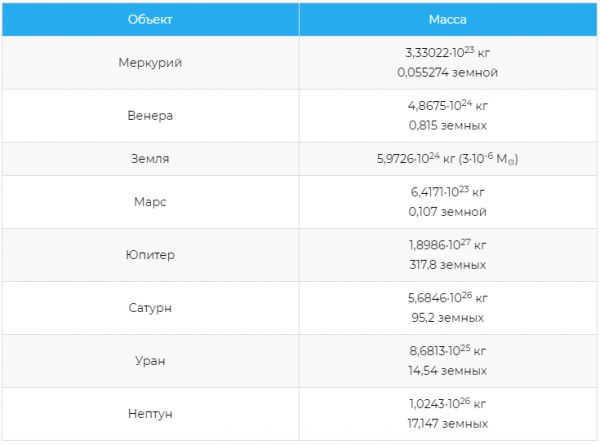
Table of the masses of the planets in the solar system
Saturn
When examining the mass of the planets in the solar system (the table is a helpful tool for organizing them in a specific order), it is important to mention this gas giant with its iconic rings. The distance between Saturn and the Sun is approximately 1.5 billion kilometers. Surrounding its core, there are layers of gas that create its distinctive appearance. The mass of Saturn is estimated to be 5.66*10^26 kilograms. It takes approximately 30 Earth years for this enormous sphere to complete one orbit around the Sun.
Saturn is known as the fourth most massive planet in our solar system. Positioned approximately 3 billion kilometers away from the Sun, this gas giant belongs to the category of ice giants, characterized by a predominantly gaseous composition. Unlike its impressive size, Saturn’s year lasts for a duration equivalent to 84 Earth periods. Interestingly, despite its size, the length of a day on Saturn is relatively short, even shorter than a day on Earth, lasting only 18 hours. Weighing in at a staggering 86.05*10^24 kg, Saturn is home to 27 satellites and possesses a minor ring system that adds to its celestial beauty.
Neptune
Neptune is located at a distance of 4.5 billion kilometers from the Sun. This gas giant has a frozen surface and is surrounded by a collection of moons and a small system of rings. It has a mass of 1.02*10^26 kilograms and takes 165 years to complete one orbit around the Sun. A Neptunian day lasts for 16 hours. It has a total of 13 moons. The surface temperature of Neptune is extremely cold, reaching as low as -300 degrees.
Therefore, by analyzing the data regarding the sizes and masses of celestial bodies, we can deduce their significant disparities. There exist both immense and diminutive entities that possess distinct properties and attributes. Despite the extensive research conducted on them, they still captivate the attention of scientists, remaining subjects of ongoing observation.
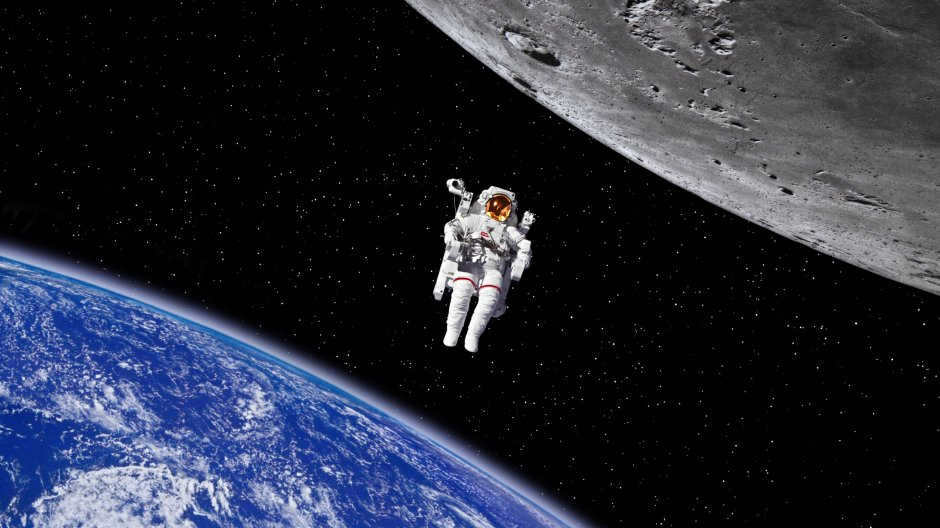
As we all know from our physics classes, the weight of any object is determined by the force of gravity. This force is directly proportional to the mass of the planet and inversely proportional to the square of its radius. Therefore, it’s evident that the weight of an object placed on the surface of a planet will vary depending on the planet’s size and magnitude.
Even on our own planet, Earth, the weight of an object can vary at different latitudes. This is because Earth is not a perfect sphere; it is flattened at the poles and stretched along the equator. As a result, a person weighing 80 kilograms near the Arctic Circle would weigh approximately 0.5 kilograms less at the equator.
Now, let’s consider how a person’s weight would change on the various planets in our solar system.
Mercury has a mass that is only 1/20th of Earth’s weight. The first radio astronomical measurements of this planet were conducted in 1961 by Howard, Barrett, and Haddock, who were Americans. In the 1970s and 2011, the Mariner and Messenger spacecraft were sent to explore Mercury. If an individual weighing 80 kg were on Mercury, their weight would be slightly over 30 kg.
Venus
Venus is often referred to as the “sister planet” of Earth due to its similar mass and size. It is only slightly smaller than our home planet. Research conducted by Soviet scientists at the Korolev Rocket and Space Corporation Energia, who sent the Venera-1 spacecraft to Venus in 1967, revealed that the weight of a person on Venus would be relatively close to that on Earth. For example, an individual weighing 80 kilograms on Earth would weigh approximately 72.5 kilograms on Venus.
Mars
Mars has a mass that is 10.7% of Earth’s mass. Scientists from both our country and abroad have been actively studying Mars since the 1960s. Various missions, such as Mars and Phobos missions from the USSR, Mariner and Viking from the USA, and Mangalyan from India, have been sent to explore this planet.
Thanks to these explorations, we now know that the weight of a human being on Mars, which is 80 kg on Earth, would be reduced to 30 kg.
Jupiter: A Unique and Mysterious Planet
With a mass equivalent to 318 times that of Earth, Jupiter is a truly remarkable celestial body. Over the years, scientists have relied on various spacecraft, such as the Pioneer (USSR) and Voyager (USA), to gather information about this enigmatic planet. Through these missions, scientists have been able to delve into Jupiter’s atmosphere, analyze its composition, measure its mass, and uncover other crucial parameters.
Interestingly, if a human being were to find themselves on Jupiter, their weight would increase exponentially. For instance, an individual weighing 80 kg on Earth would weigh a staggering 189 kg on Jupiter. However, it’s important to note that this weight is calculated for the upper cloud layer, as the solid surface of Jupiter remains shrouded in mystery. The depths of Jupiter’s surface have yet to be fully explored, leaving scientists with limited knowledge about the intricate processes taking place within.
This celestial body weighs 95 times more than the Earth. Currently, Saturn is being examined by the Hubble Space Telescope, as well as the Pioneer and Voyager spacecraft missions.
At the edge of Saturn’s cloud layer, the gravitational force on any object is equivalent to that on Earth, meaning that 80 kilograms here would weigh 73 kilograms. The reason for this is that research has revealed the remarkably low density of this planet, which is even less dense than water.
Uranus
Research conducted by the “Voyager-2” mission has revealed that Uranus has a mass equivalent to 14 times that of Earth. Interestingly, despite its relatively low density, the gravitational pull on Uranus is not significantly different from that on Earth. So, if a person weighs 80 kilograms on Earth, they would weigh approximately 71 kilograms on Uranus.
Neptune
Neptune possesses a mass equivalent to 17 times that of Earth. On this distant celestial body, often referred to as an “ice giant” due to its considerable distance from the Sun, an individual weighing 80 kg on Earth would experience a weight of 90 kilograms.
Pluto
This minuscule celestial entity, with a mass just 0.0025 times that of Earth (meaning it is a staggering 500 times lighter than our planet!), was initially discovered in 1930. Soviet scientists in the 1950s proposed that Pluto did not meet the strict criteria for being classified as a planet, instead labeling it as a “dwarf planet.” In 2006, Pluto officially lost its planetary status and was reclassified as part of a group of dwarf planets. If a person weighed 80 kilograms on Earth, their weight on Pluto would be a mere 5 kilograms.

At present, there are extra aggregated reductions (ranging from 2% to 25%) that can be accessed by 58,742 educational establishments. To determine the discount applicable to all staff members of your educational institution, kindly sign in to your personal Infoworks account.


Advanced training program
Enhancing schoolchildren’s functional literacy
In addition to this promotion, we can apply a discount specifically for your school (based on the number of your colleagues who have completed Infoworks courses).
Currently, there are additional discounts (ranging from 2% to 25%) available for 58,742 educational institutions. To determine the discount that all staff members of your school qualify for, please log in to your personal Infoworks account.


Advanced training program
Non-destructive diagnostic techniques for technical devices.
We can apply an additional discount from your educational institution to the current discount (depending on the number of colleagues who have completed Infowork courses).
Currently, 58,742 educational institutions are eligible for additional cumulative discounts ranging from 2% to 25%. To find out the discount available for all staff members of your educational institution, please log in to your personal Infoworks account.


Exploring classical Russian literature in a contemporary setting during lessons, taking into account the implementation of the Federal State Educational Standard for General Education
Breakdown of the presentation by individual slides:


Slide 3. Mercury
Slide 2. Venus
Slide 1. Earth
Slide 4. Mars

Slide 4. Jupiter
Slide 2. Saturn
Slide 3. Uranus
Slide 4. Neptune
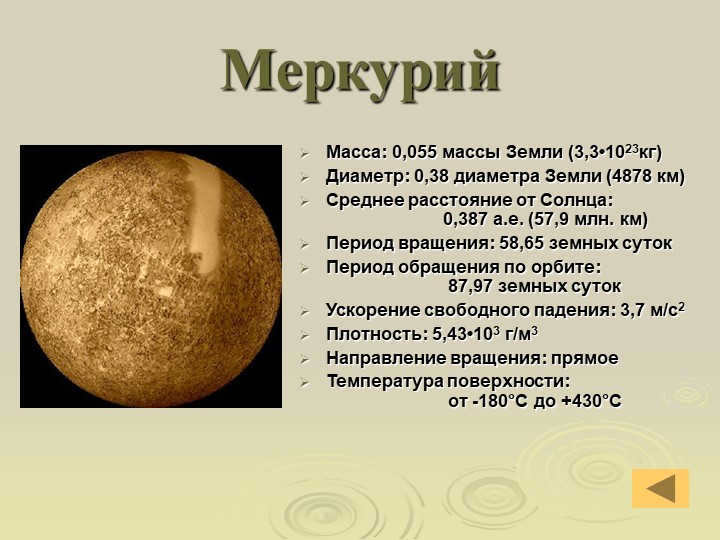
Mercury is the fifth planet from the Sun. It has a mass of 0.055 times that of Earth (3.3-1023kg) and a diameter of 0.38 times that of Earth (4878 km). Its average distance from the Sun is 0.387 astronomical units (57.9 million km). The planet has a rotation period of 58.65 Earth days and an orbital period of 87.97 Earth days. The free-fall acceleration on Mercury is 3.7 m/s2 and its density is 5.43-103 g/m3. It rotates in a straight direction and has a surface temperature that ranges from -180°C to +430°C.
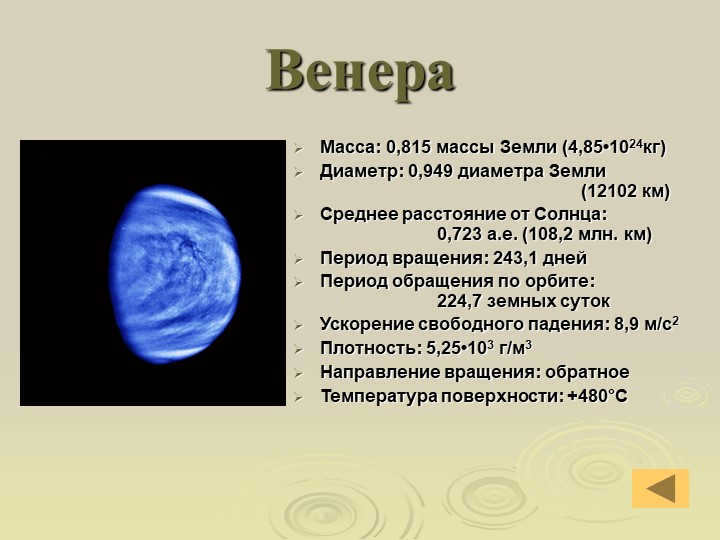
Slide 6: Venus
Mass: 0.815 times the mass of Earth (4.85-1024kg)
Diameter: 0.949 times the diameter of Earth (12102 km)
Average distance from the Sun: 0.723 astronomical units (108.2 million km)
Rotation period: 243.1 days
Orbital period: 224.7 Earth days
Free-fall acceleration: 8.9 m/s2
Density: 5.25-103 grams per cubic meter
Direction of rotation: reverse
Surface temperature: +480 degrees Celsius
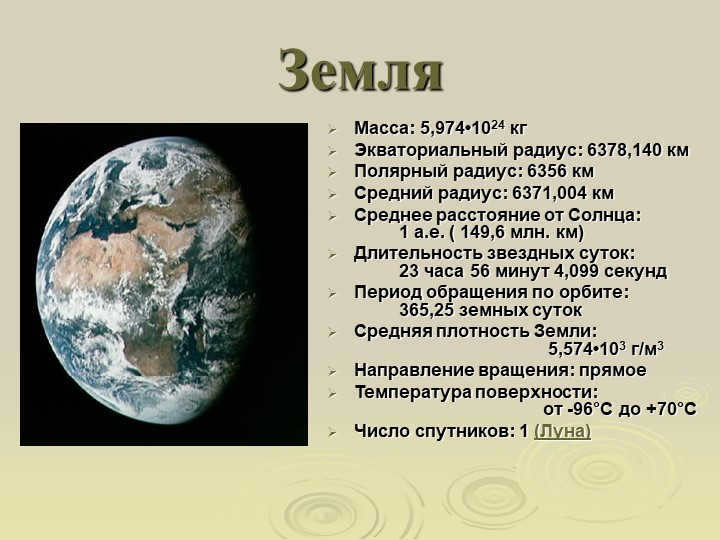
The Earth is the 7th planet in our solar system, with a mass of approximately 5.974-1024 kg. It has an equatorial radius of 6378.140 km and a polar radius of 6356 km, giving it an average radius of 6371.004 km. The Earth is located at an average distance of 1 astronomical unit (149.6 million km) from the Sun.
The Earth has a stellar day length of 23 hours, 56 minutes, and 4.099 seconds. Its orbital period is approximately 365.25 Earth days. The average density of the Earth is 5.574-103 g/m3.
The Earth rotates in a straight direction, and its surface temperature can range from -96°C to +70°C. The Earth has 1 satellite, which is the Moon.
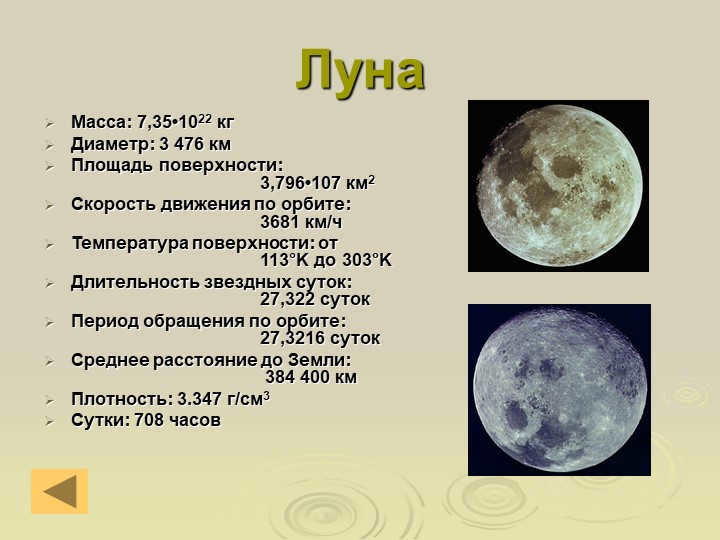
Slide 8: The Moon has a mass of 7.35-1022 kg and a diameter of 3,476 km. It has a surface area of 3.796-107 km2 and an orbital velocity of 3,681 km/h. The surface temperature ranges from 113°K to 303°K. The Moon has a stellar day length of 27.322 days and an orbital period of 27.3216 days. It has an average distance to Earth of 384,400 km and a density of 3.347 g/cm3. The Moon experiences days that last 708 hours.
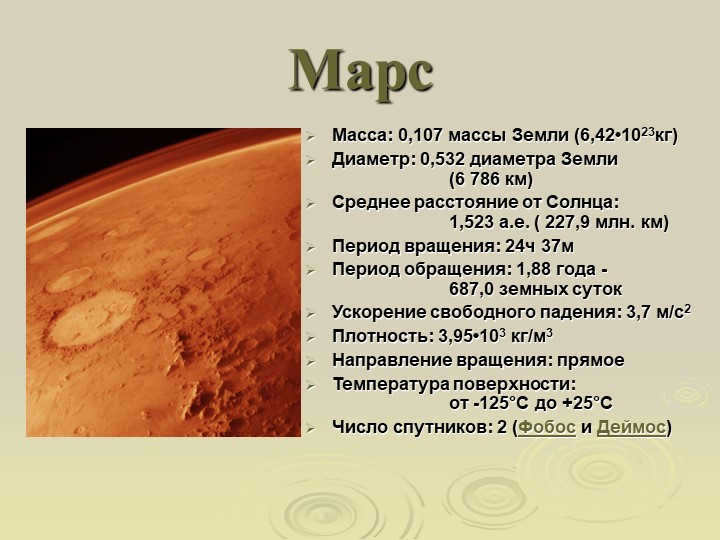
Mars is the fourth planet from the Sun in the Solar System. It has a mass of 0.107 times the mass of Earth, which is equivalent to 6.42 x 10^23 kilograms. The diameter of Mars is 0.532 times the diameter of Earth, which is approximately 6,786 kilometers.
Mars is located at an average distance of 1.523 astronomical units (227.9 million kilometers) from the Sun. It takes Mars approximately 1.88 years, or 687 Earth days, to complete one orbit around the Sun. The rotation period of Mars is 24 hours and 37 minutes.
The surface of Mars experiences a free-fall acceleration of 3.7 meters per second squared. The density of Mars is approximately 3.95 x 10^3 kilograms per cubic meter. Mars rotates in a straight direction, and its surface temperature ranges from -125°C to +25°C.
Mars has two satellites, Phobos and Deimos.
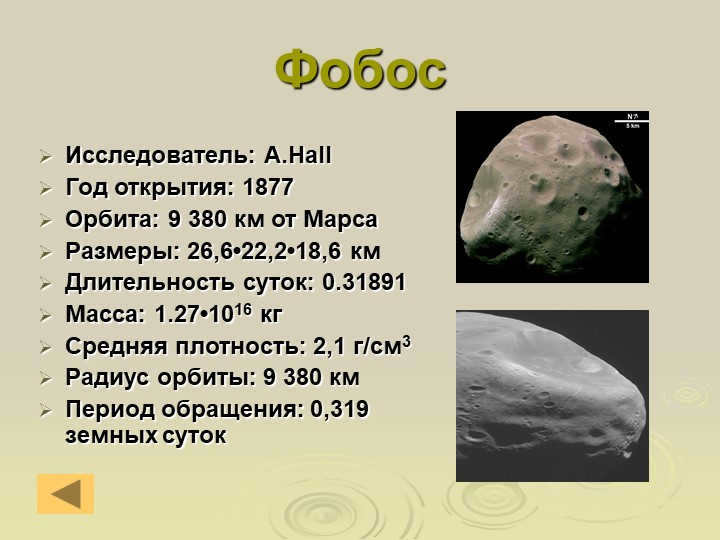
On slide 10, we have Phobos, a moon of Mars. It was first discovered in 1877 by A. Hall. Phobos orbits at a distance of 9,380 km from Mars and has dimensions of 26.6-22.2-18.6 km. Its day length is 0.31891 Earth days and it has a mass of 1.27-1016 kg. The average density of Phobos is 2.1 g/cm3. Its orbital radius is the same as its distance from Mars, 9,380 km, and its orbital period is 0.319 Earth days.
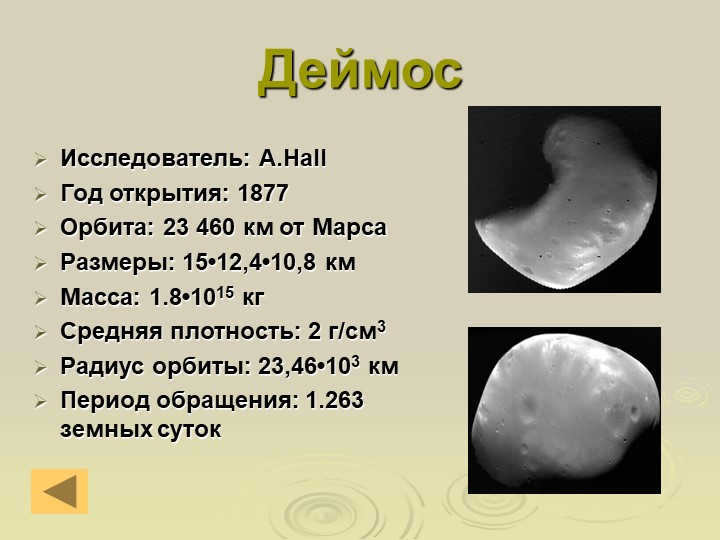
Slide 11 Deimos
Researcher: A.Hall
Year of discovery: 1877
Orbit: 23,460 kilometers away from Mars
Dimensions: 15-12.4-10.8 kilometers
Mass: 1.8-1015 kilograms
Average density: 2 grams per cubic centimeter
Orbital radius: 23.46-103 kilometers
Period of revolution: 1.263 Earth days
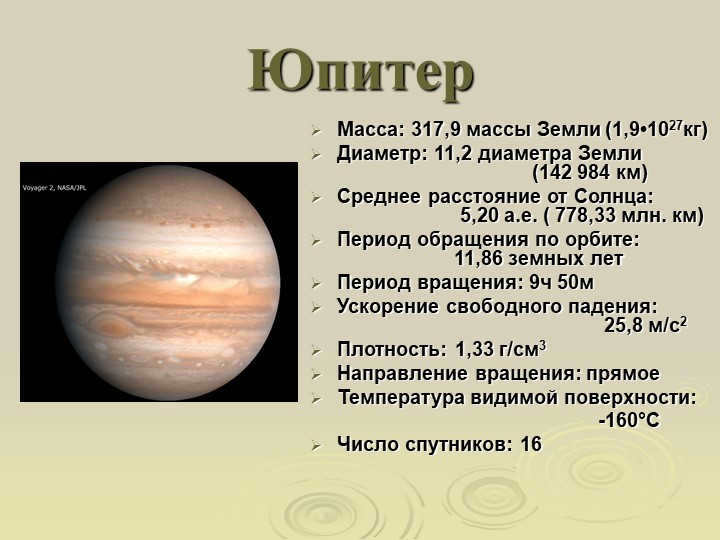
Jupiter is the largest planet in our solar system. It has a mass of 317.9 times that of Earth, which is equivalent to a range of 1.9-1027 kilograms. The diameter of Jupiter is 11.2 times that of Earth, measuring 142,984 kilometers. It is located at an average distance of 5.20 astronomical units (778.33 million kilometers) from the Sun. Jupiter has an orbital period of 11.86 Earth years and a rotation period of 9 hours and 50 minutes. The free-fall acceleration on Jupiter is 25.8 meters per second squared, and its density is 1.33 grams per cubic centimeter. Jupiter’s direction of rotation is straight, and its visible surface temperature is -160 degrees Celsius. Additionally, Jupiter has a total of 16 satellites.
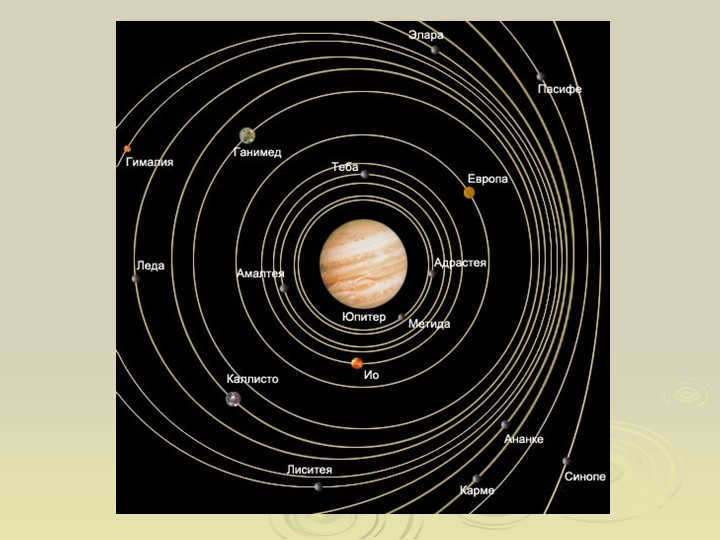
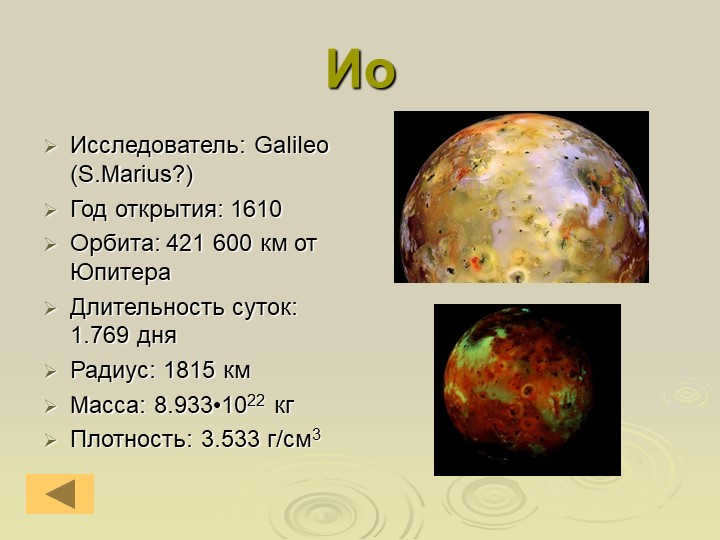
The fifteenth slide of Io Explorer is attributed to Galileo (possibly Simon Marius) and was discovered in 1610. It orbits at a distance of 421,600 km from Jupiter and has a day length of 1.769 days. The radius of Io is 1,815 km and its mass is approximately 8.933 x 10^22 kg. With a density of 3.533 g/cm3, Io is an intriguing moon of Jupiter.
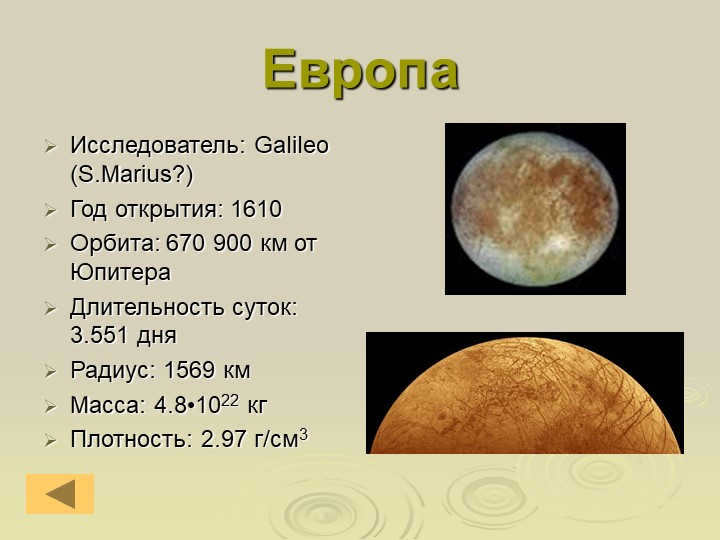
Europa, the 16th moon of Jupiter, was first discovered by Galileo (or possibly Simon Marius) in 1610. It has an orbit distance of 670,900 km from Jupiter and a day length of 3.551 days. Europa has a radius of 1569 km and a mass of 4.8-1022 kg, with a density of 2.97 g/cm3.
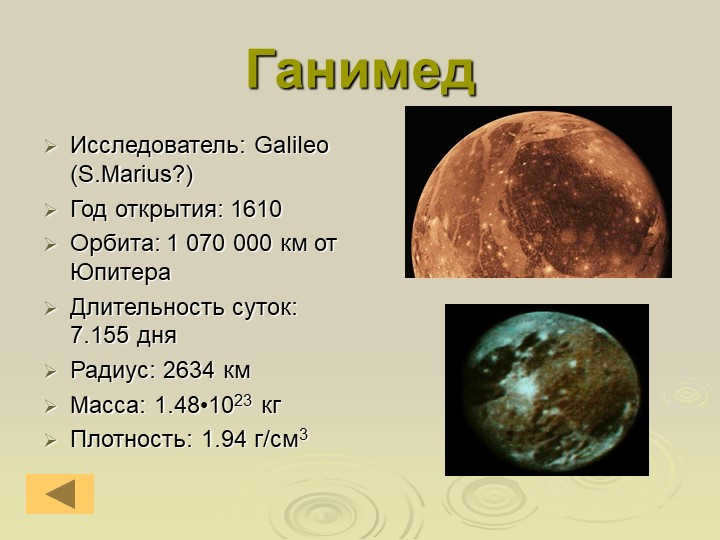
Slide 17 Ganymede
Discoverer: Galileo (S.Marius?)
Year of detection: 1610
Orbit: 1,070,000 km away from Jupiter.
Length of a day: 7.155 days
Size: 2,634 km in diameter
Weight: 1.48-1023 kg
Density: 1.94 g/cm3
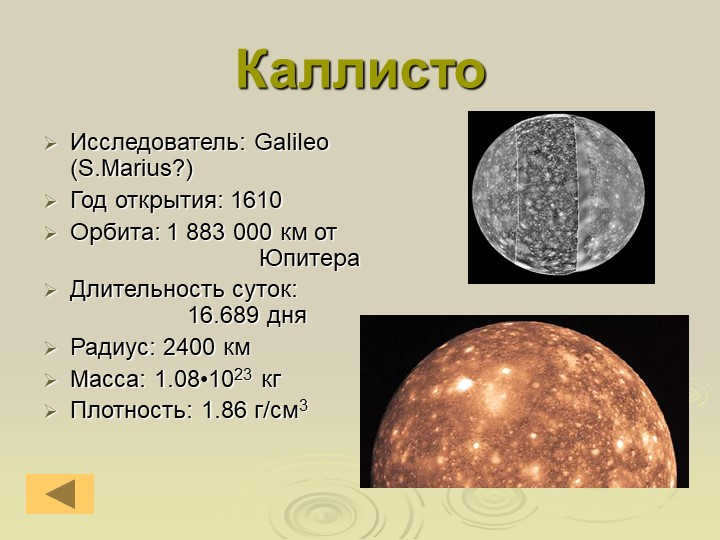
18th slide Callisto is a moon of Jupiter that was discovered by Galileo (possibly S.Marius) in 1610. It has an orbit of 1,883,000 km from Jupiter and a day length of 16.689 days. Callisto has a radius of 2,400 km, a mass of 1.08-1023 kg, and a density of 1.86 g/cm3.
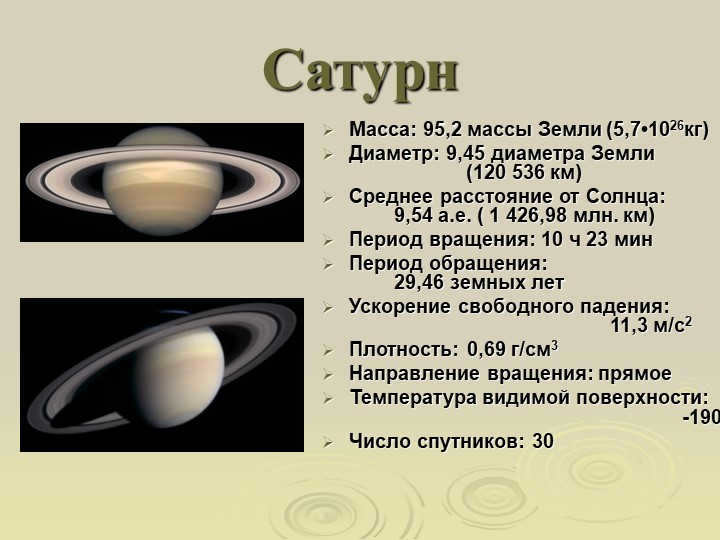
Saturn, the 19th planet in our solar system, has a mass of 95.2 times that of Earth, ranging from 5.7 to 1026kg. Its diameter is 9.45 times that of Earth, equivalent to 120,536 km. The average distance from the Sun is 9.54 astronomical units, which is equal to 1,426.98 million km. Saturn has a rotation period of 10 hours and 23 minutes, and it takes 29.46 Earth years to complete one orbit around the Sun. The free-fall acceleration on Saturn is 11.3 m/s2, and its density is 0.69 g/cm3. The direction of rotation is straight, and the visible surface temperature is -190 degrees Celsius. Saturn is also known to have 30 satellites orbiting around it.
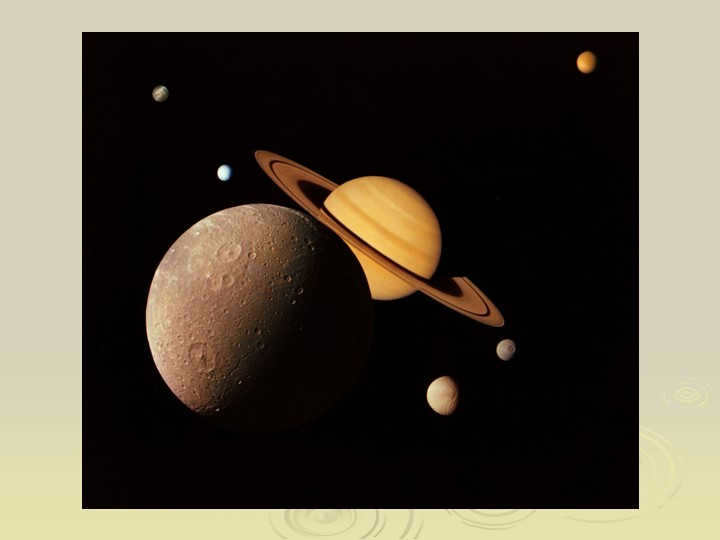
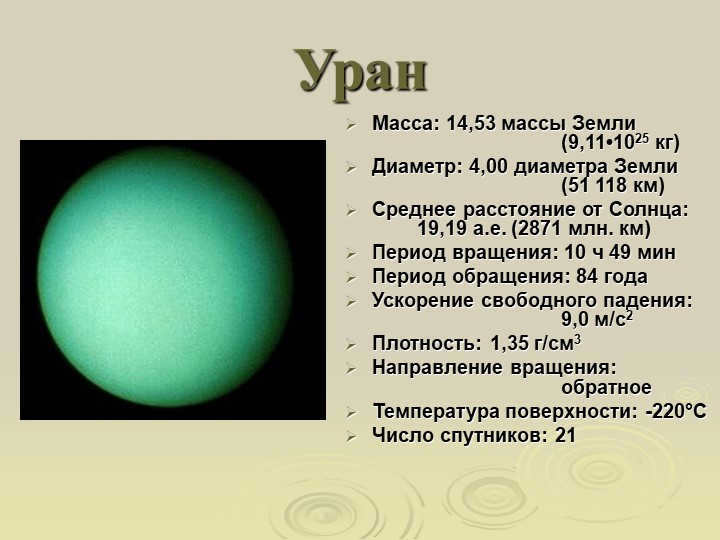
Uranus, the 22nd planet in our solar system, has a mass equivalent to 14.53 Earth masses (approximately 9.11-1025 kg). It has a diameter that is 4.00 times the diameter of Earth, measuring at 51,118 km. Uranus is located at an average distance of 19.19 astronomical units (or 2871 million km) from the Sun. It has a rotation period of 10 hours and 49 minutes and a circulation period of 84 years. The free fall acceleration on Uranus is approximately 9.0 m/s2. Its density is 1.35 grams per cubic centimeter. Unlike most planets, Uranus rotates in the opposite direction. The surface temperature on Uranus is a chilling -220°C. Uranus is also known for its 21 satellites.
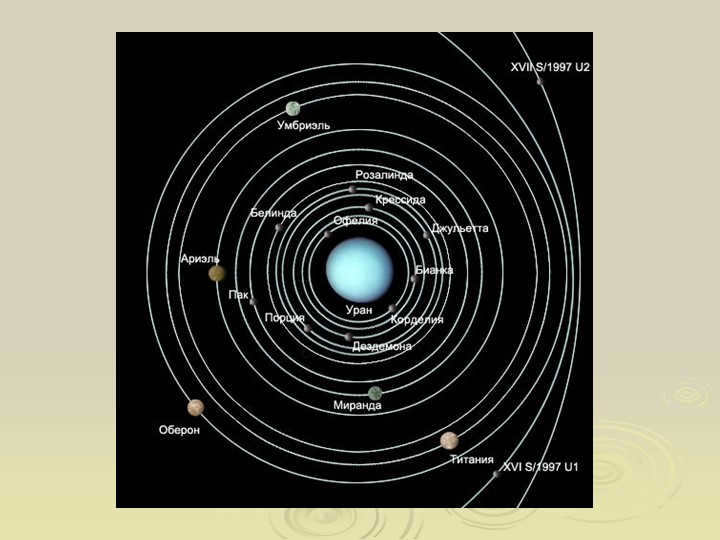
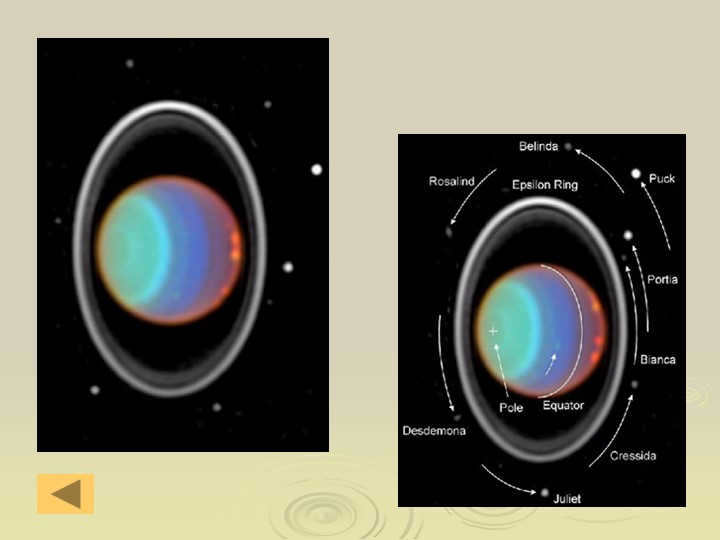
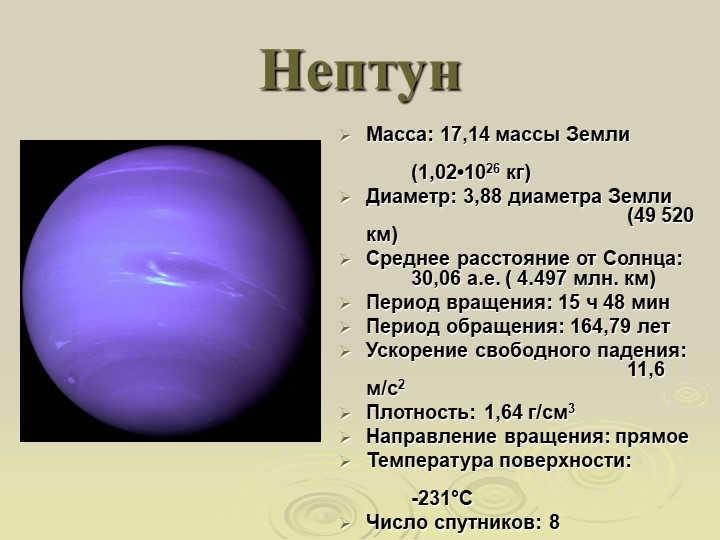
Neptune is the 25th slide in our solar system. It has a mass of 17.14 Earth masses, which is equivalent to 1.02-1026 kg. The diameter of Neptune is 3.88 times the diameter of Earth, which is approximately 49,520 km. It is located at an average distance of 30.06 astronomical units from the Sun, which is equivalent to 4.497 million km. The rotation period of Neptune is 15 hours and 48 minutes, while its circulation period is approximately 164.79 years. The free-fall acceleration on Neptune is 11.6 m/s2 and its density is 1.64 g/cm3. Neptune rotates in a straight direction. The surface temperature on Neptune is a chilling -231°C. Lastly, Neptune has 8 satellites orbiting around it.
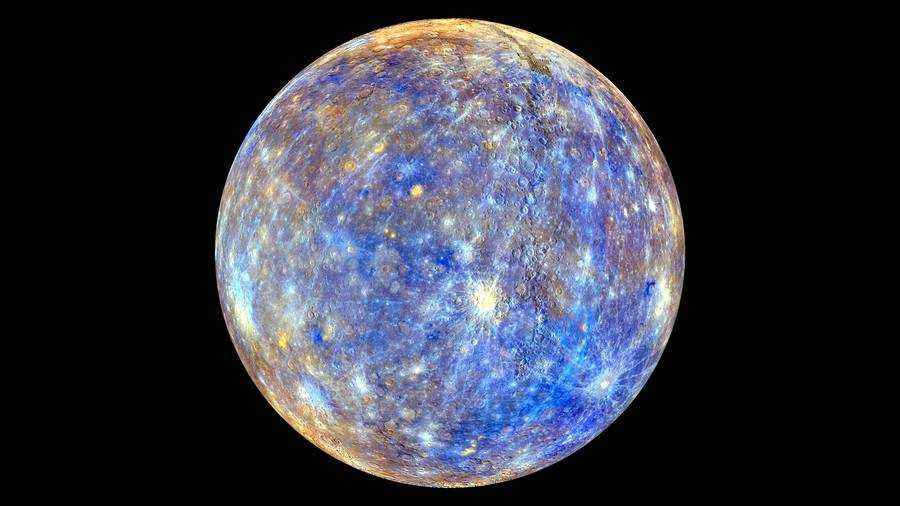
There are eight planets in the solar system, and they can be categorized into two primary groups: the terrestrial planets (including Venus, Mercury, Earth, and Mars) and the gas giants (such as Uranus, Saturn, Neptune, and Jupiter). All of these planets orbit around the Sun, and six of them have their own natural satellites. The surface of Mercury is similar to that of the Moon, featuring vast plains and craters, indicating the absence of volcanic activity for thousands of years. Even though Mercury is the smallest planet in the solar system, Jupiter holds the record for being the largest. The most effective way to determine a planet’s size is by measuring its volume and the amount of matter it contains.
Mercury’s Mass and Size
Mercury has an average radius of 2439.7±1 km, which is about 38% of Earth’s radius. It is a perfectly spherical planet with no flattened poles, so the radius at the equator is the same as at the poles. In terms of diameter, Mercury is about 2.5 times smaller than Earth. While it may be smaller than some other celestial bodies in the solar system, like Titan and Ganymede, it is still quite substantial. Mercury has a mass of 3.3011×10²³ kg, which is closer to the size of the Moon than the Earth. In fact, it is nearly 20 times smaller in both mass and volume compared to Earth.
Density and volume of Mercury
Mercury possesses a greater density compared to certain larger planets. With a density measuring 5.427 g/cm³, it stands as the second most dense planet within our solar system, following Earth, which has a density of 5.5153 g/cm³. The gravitational force on Mercury amounts to approximately 0.38 times that of Earth’s. Consequently, if you were to stand on Mercury, your weight would decrease by 62% in comparison to your weight on your home planet. The volume of Mercury is roughly 0.056 times that of Earth’s.
Structure and Composition of Mercury
Mercury belongs to the group of terrestrial planets and consists of a combination of metals and silicate minerals. The planet is divided into distinct layers including a crust, silicate mantle, and metallic core. What sets Mercury apart from other planets is its exceptionally large core, measuring approximately 1800 km in radius. This core accounts for about 55% of the planet’s volume, whereas Earth’s core only makes up around 17%. Interestingly, Mercury’s core is rich in iron compared to the cores of other planets in our solar system, and numerous theories have been proposed to explain this unique characteristic.
Planetary mass refers to the measurement of mass associated with a planet-like object. In our solar system, planets are typically measured using the astronomical system of units, with the mass of the Sun (M☉) serving as the unit of mass. When studying exoplanets, the standard unit of measurement is often the mass of Jupiter (MJ) for large gas giant planets, and the mass of the Earth (M⊕) for smaller rocky terrestrial planets.
The mass of a planet in the solar system can be adjusted as a customizable parameter when preparing ephemerides. There are three options available for calculating planetary mass:
- If a planet possesses natural satellites, its mass can be determined by applying Newton’s law of universal gravitation, which provides a modified version of Kepler’s third law incorporating the mass of both the planet and its moon. This approach enabled early measurements of Jupiter’s mass in terms of solar mass units.
- The mass of a planet can be inferred from its impact on the orbits of other planets. However, between 1931 and 1948, flawed applications of this method resulted in inaccurate calculations of Pluto’s mass.
- Data gathered from the orbital paths of space probes can also be utilized. Notable examples include the Voyager probes, which explored the outer planets, and the MESSENGER spacecraft, which studied Mercury.
- Moreover, there are several alternative approaches that can provide acceptable estimations. For instance, Varuna, a potential dwarf planet, exhibits a fast rotation on its axis, similar to the dwarf planet Haumea. Haumea’s ability to resist being torn apart by centrifugal forces suggests that it has a remarkably high density. By performing certain calculations, it is possible to establish a limit on the object’s density. Consequently, if the object’s size is known, it becomes feasible to determine the maximum mass. For additional details on this topic, please refer to the References provided in the aforementioned articles.
Selection of Units
The selection of solar mass, M ☉, as the fundamental unit for measuring planetary mass is based on calculations used to determine the mass of planets. In the case of Earth, the most accurate measurement of its mass is known to twelve significant figures when expressed in solar mass units. In comparison, the mass expressed in kilograms or other terrestrial units is only known to five significant figures, which is less accurate by a factor of one millionth.
The Sun is a massive object in the solar system, weighing approximately 1.9884 (2) x 10 30 kg. When compared to the Sun’s mass, Jupiter, the largest planet, is only 0.09% of its weight, while the Earth is a mere 0.0003% of the Sun’s mass. Different conventions exist to address this issue: some express a planet’s mass as the number of planets it would take to equal the Sun’s weight. In this particular case, we have opted to measure planetary masses in “microSuns” – meaning the Earth’s mass is slightly over three “microSuns”, or three millionths of the Sun’s mass, unless otherwise specified in kilograms.
When making comparisons between planets, it is frequently convenient to utilize Earth’s mass (ME or M⊕) as a standard, especially for terrestrial planets. For gas giants, as well as the majority of extrasolar planets and brown dwarfs, Jupiter’s mass (MJ) serves as a convenient point of comparison.
| Mercury | Venus | Earth | Mars | Jupiter | Saturn | Uranus | Neptune |
| 0.0553 | 0.815 | 1 | 0.1075 | 317.8 | 95.2 | 14.6 | 17.2 |
| 0.00017 | 0.00256 | 0.00315 | 0.00034 | 1 | 0.299 | 0.046 | 0.054 |
The formation of planets and their mass
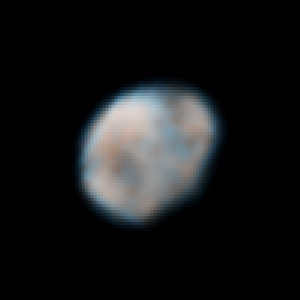
Vesta, the second largest object in the asteroid belt after Ceres, is depicted in this image captured by the Hubble Space Telescope. The image reveals that Vesta does not have a perfectly spherical shape.
The mass of a planet plays a significant role in its structure, especially during its formation. If a planet has a large mass, exceeding one ten thousandth of Earth’s mass, it can overcome its compressive strength and achieve hydrostatic equilibrium. As a result, the planet will become roughly spherical. Starting from 2006, such objects have been classified as dwarf planets if they orbit the Sun independently, without being a satellite of another planet. On the other hand, smaller objects like asteroids are referred to as “small solar system bodies.”
The smaller planets consist solely of silicates and are known as terrestrial planets, such as Earth or Mars, although there are also multiple super-Earths with a mass, denoted as ME. The internal structure of rocky planets is dependent on their mass. For instance, plate tectonics may require a minimum mass in order to generate the necessary temperatures and pressures for this process to occur.
If a protoplanet increases in size through accretion and reaches more than 5-10 M⊕, its gravitational force would become strong enough to retain hydrogen in its atmosphere. It would then develop into a gas giant. If the planet subsequently undergoes migration, it may move within the frost line of its system and become a hot Jupiter, orbiting very close to its star and gradually losing a small amount of mass as the star’s radiation disintegrates its atmosphere.
The estimated minimum mass for a star, where hydrogen fusion occurs in the core, is approximately 75 MJ. However, deuterium fusion can occur at masses as low as 13 Jupiters.
Values obtained from the DE405 ephemeris
The DE405 / LE405 ephemerides, developed by the Jet Propulsion Laboratory, are widely used ephemerides that have been in use since 1998 and cover the entire solar system. The planetary masses derived from these ephemerides form a consistent set, which is not always the case with more recent data (see below).
| Mercury | 0. 166 01 | 3.301 × 10 23 kg | 5.43 g / cm 3 | ||
| Venus | 2. 447 8383 | 4.867 × 10 24 kg | 5.24 g / cm 3 | ||
| Earth/Moon system | 3 040 432 633 33 | 6.046 × 10 24 kg | 4.4309 g / cm 3 | ||
| Earth | 3. 003 489 596 32 | 5.972 × 10 24 kg | 5.514 g / cm 3 | ||
| Moon | 1. 230 003 83 × 10 −2 | 7.348 × 10 22 kg | 3.344 g / cm 3 | ||
| Mars | 0,3227151 | 6.417 × 10 23 kg | 3.91 g / cm 3 | ||
| Jupiter | 954,79194 | 1.899 × 10 27 kg | 1.24 g / cm 3 | ||
| Io | 4,70 × 10 −5 | 8.93 × 10 22 kg | |||
| Europa | 2,53 × 10 −5 | 4.80 × 10 22 kg | |||
| Ganymede | 7,80 × 10 −5 | 1.48 × 10 23 kg | |||
| Callisto | 5,67 × 10 −5 | 1.08 × 10 23 kg | |||
| Saturn | 285,8860 | 5.685 × 10 26 kg | 0.62 g / cm 3 | ||
| Titan | 2,37 × 10 −4 | 1.35 × 10 23 kg | |||
| Uranus | 43,66244 | 8.682 × 10 25 kg | 1.24 g / cm 3 | ||
| Titania | 4,06 × 10 −5 | 3.52 × 10 21 kg | |||
| Oberon | 3,47 × 10 −5 | 3.01 × 10 21 kg | |||
| Neptune | 51,51389 | 1.024 × 10 26 kg | 1.61 g / cm 3 | ||
| Triton | 2,09 × 10 −4 | 2.14 × 10 22 kg | |||
| Pluto/Charon system | 0,007396 | 1.471 × 10 22 kg | 2.06 g / cm 3 | ||
| Ceres | 0,00047 | 9.3 × 10 20 kg | |||
| Vesta | 0,00013 | 2.6 × 10 20 kg | |||
| Pallada | 0,00010 | 2.0 × 10 20 kg | |||
Mass of Earth and Moon
When a planet has moons, the mass of the whole system (planet + moons) is usually provided because it is the total mass that affects the orbits of other planets. The difference is negligible since moons are much smaller than their host planets (as shown in the table above, which only includes the largest moons).
An example of this is the Earth and the Moon, where the Moon is unusually large (accounting for just over 1% of the Earth’s mass) compared to other moons. The Earth-Moon system also has highly precise data available, especially from the Lunar Laser Long Range (LLR) experiment.
The geocentric gravitational constant, which is the result of multiplying the mass of the Earth by the Newtonian gravitational constant, can be precisely calculated by studying the orbits of the Moon and man-made satellites. The relative masses of the Earth and the Moon can be derived by observing the slight perturbation in the Earth’s orbit caused by the gravitational force exerted by the Moon.
Recent values
Creating accurate and comprehensive ephemerides of the solar system is a challenging task. It is possible (though somewhat easier) to generate partial ephemerides that focus solely on specific planets (or dwarf planets, satellites, asteroids) by “fixing” the motion of other planets in the model. These two methods are not exactly the same, particularly when it comes to determining uncertainties in the results. However, the most reliable estimates – especially in terms of uncertainty – for the masses of small planets and asteroids are typically derived from partial ephemerides.
Nevertheless, there are ongoing efforts to create fresh and comprehensive ephemerides, with the EPM2004 ephemeris from the Institute of Applied Astronomy of the Russian Academy of Sciences being particularly noteworthy. EPM2004 utilizes a staggering 317,014 distinct observations spanning from 1913 to 2003, which is over seven times the amount used in DE405. As a result, EPM2004 was able to provide more precise measurements for the masses of Ceres and five other asteroids.
| 136199 Eris | 84.0 (1.0) × 10-6 | |
| 134340 Pluto | 73,224 (15) × 10-6 | |
| 136108 Haumea | 20.1 (2) × 10-6 | |
| 1 Ceres | 4.753 (7) × 10-6 | 4.72 (3) × 10-6 |
| 4 Vesta | 1.344 (1) × 10-6 | 1.35 (3) × 10-6 |
| 2 Pallas | 1.027 (3) × 10-6 | 1.03 (3) × 10-6 |
| 15 Eunomia | 0.164 (6) × 10-6 | |
| 3 Juno | 0.151 (3) × 10-6 | |
| 7 Iris | 0.063 (1) × 10-6 | |
| 324 Bamberg | 0.055 (1) × 10-6 |
The 27th General Assembly of the International Astronomical Union (IAU) in August 2009 approved a fresh collection of “current best estimates” for numerous astronomical constants.
| Mercury | 6023.6 (3) × 10 3 | 0.166 014 (8) | 3.30 × 10 (3) × 10 23 |
| Venus | 408,523,719 (8) × 10 3 | 2,081,062.72 (3) | 4.1380 (4) × 10 24 |
| Mars | 3098.70359 (2) × 10 3 | 0.3232371722 (21) | 6.4273 (6) × 10 23 |
| Jupiter | 1,047,3486 (17) × 10 3 | 954,7919 (15) | 1.89852 (19) × 10 27 |
| Saturn | 3.4979018 (1) × 10 3 | 285.885670 (8) | 5.6846 (6) × 10 26 |
| Uranus | 22.90298 (3) × 10 3 | 43.66244 (6) | 8.6819 (9) × 10 25 |
| Neptune | 19.41226 (3) × 10 3 | 51.51384 (8) | 1.02431 (10) × 10 26 |
Latest IAU Estimates (2012)
The 2012 update to the “current best estimates” was made by Resolution B2 at the XXVIII IAU General Assembly. Revised values were provided for Mercury and Uranus (as well as for the Pluto and Vesta systems).
| Mercury | 6023.657 33 (24) × 10^3 |
| Uranus | 22.902 951 (17) × 10^3 |





